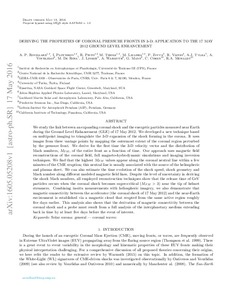Deriving the Properties of Coronal Pressure Fronts in 3D: Application to the 2012 May 17 Ground Level Enhancement
G. Mann; A. J. Tylka; R. A. Mewaldt; M. Lavarra; J. Linker; R. F. Pinto; A. Vourlidas; R. Vainio; M. Tirole; A. P. Rouillard; M. L. De Rosa; P. Zucca; I. Plotnikov; C. M. S. Cohen; A. Warmuth
https://urn.fi/URN:NBN:fi-fe2021042715979
Tiivistelmä
We study the link between an expanding coronal shock and the energetic particles measured near Earth during the ground level enhancement of 2012 May 17. We developed a new technique based on multipoint imaging to triangulate the three-dimensional (3D) expansion of the shock forming in the corona. It uses images from three vantage points by mapping the outermost extent of the coronal region perturbed by the pressure front. We derive for the first time the 3D velocity vector and the distribution of Mach numbers, M FM, of the entire front as a function of time. Our approach uses magnetic field reconstructions of the coronal field, full magnetohydrodynamic simulations and imaging inversion techniques. We find that the highest M FM values appear near the coronal neutral line within a few minutes of the coronal mass ejection onset; this neutral line is usually associated with the source of the heliospheric current and plasma sheet. We illustrate the variability of the shock speed, shock geometry, and Mach number along different modeled magnetic field lines. Despite the level of uncertainty in deriving the shock Mach numbers, all employed reconstruction techniques show that the release time of GeV particles occurs when the coronal shock becomes super-critical (M FM > 3). Combining in situ measurements with heliospheric imagery, we also demonstrate that magnetic connectivity between the accelerator (the coronal shock of 2012 May 17) and the near-Earth environment is established via a magnetic cloud that erupted from the same active region roughly five days earlier.
Kokoelmat
- Rinnakkaistallenteet [19240]
